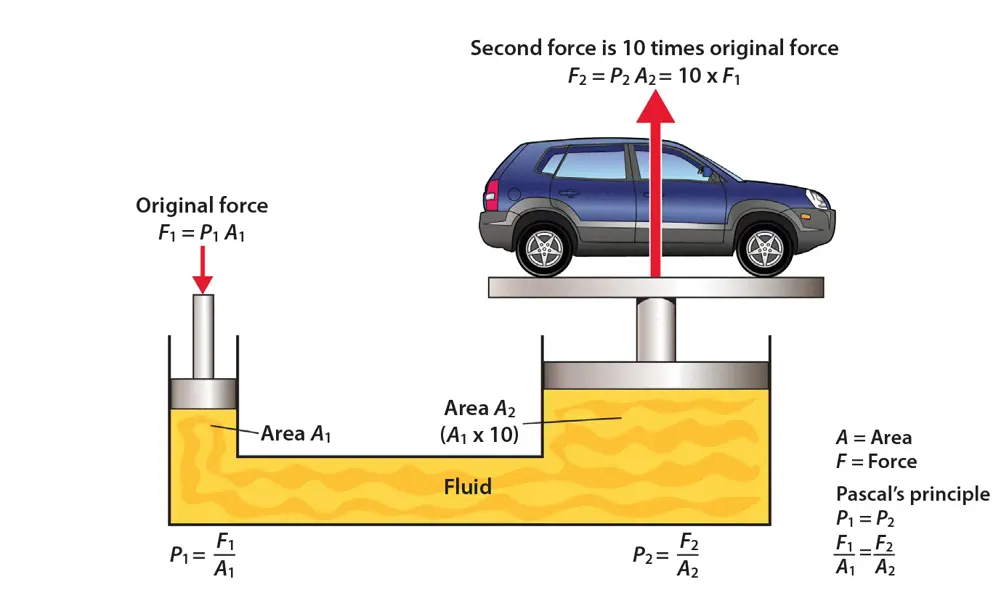
How do hydraulic presses work?
After a long day, what could be more relaxing than watching an assortment of everyday objects buckle, break, spaghettify, and even explode under intense pressure? With over nine million subscribers to the Hydraulic Press Channel on YouTube, perhaps not much.
On the channel, Lauri Vuohensilta and Hanna Korpisaari squash various fruit, toys, tools, even concrete and metal under a 150-tonne hydraulic press in their workshop in Finland. It’s captivating viewing, but what’s actually going on? How is it that we can create these obscenely large forces, with relatively little input?
The multiplier effect
“The basic principle of the hydraulic press is that you can use a small force to generate a large force,” says Adam Wojcik, associate professor at UCL’s Department of Mechanical Engineering.
He explains that in its simplest form, the hydraulic press is two syringes connected by a pipe filled with an incompressible fluid, usually oil. When you press on one syringe, this force is transmitted through the fluid to the other syringe, in this ‘hydraulic circuit’.
It’s a demonstration of Pascal’s principle, which states that pressure applied to a fluid will be transmitted evenly throughout the fluid and to the walls it’s contained in. Where things get interesting, however, is that the force being applied can be increased at the other end of the hydraulic circuit, simply by changing a few dimensions.

© Encyclopaedia Britannica, Inc 2012
Pressure on a surface is equal to the perpendicular force on it, divided by its area. As the pressure is the same throughout the fluid, the force applied to a relatively small area at one end of the system will multiply when applied to a relatively large area at the other end. So, if the area of the first syringe being pressed is half that of the second, you’ll get double the force at the second syringe. “You don’t get something for nothing, however – the force might be doubled, but the movement that the force creates, will halve, so as to keep the overall work (energy) expended the same,” Adam adds.
In a hydraulic press, this first ‘syringe’, where the smaller force is applied, is technically known as the pump, while the second, applying the larger force, is known as the ram. This multiplier effect is why mechanics can raise a one-tonne car with a few pumps of the handle. Inside the car, another hydraulic system ensures that when you apply the brakes with a modest force, the car comes – with the help of friction, of course – to a stop.
Hydraulic presses in industry
Hydraulic presses are used to forge or shape materials including car parts and panels of domestic appliances, and to form concrete into different shapes for construction, as well as to punch out and join together different materials.
Andrew Pilkington, a senior research associate at the University of Oxford’s Department of Engineering Science, notes that hydraulics can also be used to apply a large turning force for tightening bolts: “As the bolts get very large in diameter, you need a lot of force to tighten them,” he says. “You’d either have to use a very, very long spanner, or a very, very large force. Hydraulic torque wrenches are a good way of providing that force without having to use an unwieldy 10-metre-long spanner, which would be unwieldy.”
In Lauri and Hanna’s videos, the presses generate compressive forces of between 150 and 300 tonnes, but hydraulic presses can go up to the order of thousands or even hundreds of thousands of tonnes.
The 100,000-tonne hydraulic press at GIVA’s Forgiatura A Vienna facility in Italy, known as ‘Tyson’, forges turbine wheels for power generation and is thought to be the largest in the world.
Change in gear
While you’re watching the videos on Hydraulic Press Channel, consider paying close attention to what you hear as well. “One thing that you sometimes hear in the videos is a change in tone,” notes Pilkington.
You might have noticed this – when the press starts its journey towards the object to be crushed, it makes a certain noise that changes as it starts to struggle against the object. It then makes a different noise when the press continues its journey. This may be due to a switch in the pump being used, says Pilkington.
“Sometimes hydraulic systems will have two different pumps in them,” he adds. “One is producing a higher flow, so it’ll move the press quicker, but with less force. A high-pressure pump produces more force but actually doesn’t move the press quite as fast. When you hear it changing noise, one of the reasons is that it might be switching to the higher pressure pump.”
With a pump system, there’s a trade-off between flow and pressure. “Having one pump that can do everything is difficult,” explains Pilkington. “So you have a pump that can put out a reasonable flow of reasonable pressure, but if you want a really, really, high pressure, that pump can’t do it. So you switch to a different pump that can produce very high pressures but at a low flow.”
“The basic principle of the hydraulic press is that you can use a small force to generate a large force.”
Adam Wojcik, Associate Professor, UCL’s Department of Mechanical Engineering
An unexpected application
Wojcik’s team measures the properties of novel materials for engineers. “Engineers use those properties to design and create things, so those properties have to be measured,” he says.
The team uses sophisticated versions of hydraulic presses to test materials’ compressive and tensile strength to ensure they’ll bear up against repeated use over time. “[If] you’re building components or structures, particularly things like buildings, roads, bridges and things like that... you need to test the materials in compression.”
In a more inventive use of the technology, Wojcik has also used a hydraulic press to help solve a problem presented by the University of Reading’s archaeology department.
The team wanted to see if it would be possible to date an archaeological site by examining the wear on coins found on the site. “It’s well known that coins wear, and that the wear on profile features relates to how long the coins have been in circulation,” Wojcik says.

© Image by aleksandra85foto from Pixabay
A study on current 2p coins by Wojcik’s team confirmed that wear increases with age, but in the case of ancient coins, what if the die used to strike the coin was worn? “You might have a newly minted coin that looks worn because the die used was old and worn itself,” he explains.
Using a hydraulic press, the team ‘minted’ their own fake coins out of brass discs, and then tumbled them in a rotary stone polisher to accelerate this ‘natural’ wear. They found that this kind of wear has different hallmarks to the ‘artificial’ wear an old die would impress on a new coin.
“This… allowed us to confirm that we could tell the difference between a coin worn by use and a coin that looked worn because the die was worn,” he says, making it possible – in theory – to better date an archaeological site by looking at its coins.
Contributors
Leonie Mercedes is a freelance writer based in London.
Keep up-to-date with Ingenia for free
SubscribeRelated content
Mechanical

When will cars drive themselves?
There are many claims made about the progress of autonomous vehicles and their imminent arrival on UK roads. What progress has been made and how have measures that have already been implemented increased automation?

R&D investment makes good business sense
In just five years, Dr Ralf Speth FREng has presided over a revolution in design and manufacturing that has helped create a new family of engines and has overhauled Jaguar Land Rover (JLR) production facilities.

Bikes help improve skills and attitude
The Archway Project is an independently-funded scheme that is expanding its engineering-based programmes by providing BTEC certificates and diplomas. John Milton, the director of the project, explains what the charity does to help reduce anti-social behaviour and improve employment prospects.

High speed evolution
In December 2010, Eurostar International Ltd awarded a contract for 10 new high speed trains to Siemens. The company has used a system developed over decades to maximise the performance and passenger-carrying ability of its 320km/h trains.
Other content from Ingenia
Quick read

- Environment & sustainability
- Opinion
A young engineer’s perspective on the good, the bad and the ugly of COP27

- Environment & sustainability
- Issue 95
How do we pay for net zero technologies?
Quick read

- Transport
- Mechanical
- How I got here
Electrifying trains and STEMAZING outreach

- Civil & structural
- Environment & sustainability
- Issue 95